Practicing the principles of permaculture at Kahikatea farm
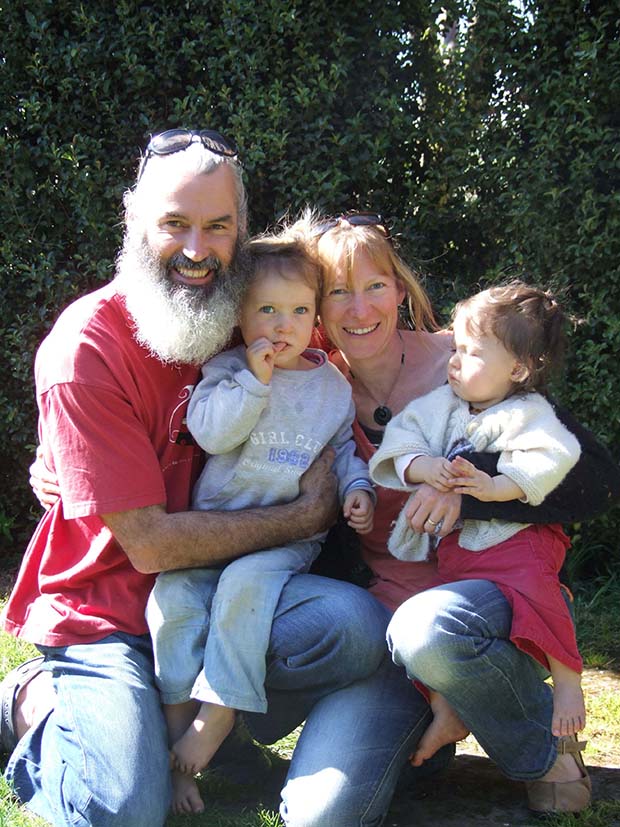

This enterprising couple doesn’t just want to create a green future for their family – they want to create a sustainable lifestyle for their whole community.
Words: Nadene Hall
Photos: Jo & Aaron Duff
Who: Jo and Aaron Duff, Kahikatea Farm
Where: Poukawa Valley, 16km south-west of Hastings
What: 6.5ha (16 acres)
Philosophy: permaculture, organic and biodynamic agriculture
Web: www.kahikateafarm.co.nz
If you don’t know about the principles of permaculture design then Jo and Aaron Duff’s block probably looks a bit strange. There are few fences, lots of untamed vegetation and some strange-looking earthworks.
But it’s all part of the permaculture design philosophy that is at the heart of their block, where everything will grow to support and nurture everything else, mimicking what would happen in nature. The idea is to create a landscape that is self-sustaining, able to feed its people and its wider community with no inputs, other than what it creates itself.

Eliza (left) and Anna pick cornflowers to go in their salad for dinner.
The mixed plantings on the Duff’s block are a good example. There are no monocultures in permaculture, and ideally, every plant should have multiple roles so there’s a nitrogen-fixing tree like tagasaste (Chamaecytisus palmensis, tree lucerne) that provides:
– fertility to the soil;
– excellent shelter;
– great fodder for livestock in times of drought;
– abundant flowers to feed bees and birds.
Within the sheltering arms of the tagasaste are slower-growing trees like the apples that have been carefully grafted onto hardy rootstocks. These will eventually outgrow the tagasaste (which is fairly short-lived at 10-15 years) to provide fruit, shelter for other smaller plants beneath it, and even possibly a physical framework for climbing plants like passionfruit or grapes.
Permaculture is a philosophy of working with, rather than against nature; of protracted and thoughtful observation rather than protracted and thoughtless labour; and of looking at plants and animals in all their functions, rather than treating any area as a single project system.
Bill Mollison, co-founder of permaculture
Another fundamental of permaculture is to design to your particular environment after careful observation. When Jo and Aaron bought their block it was three paddocks with two low-lying areas on either side of a gently-sloping hill. Learning how the land and climate make their way through the seasons is important, especially in a region where rainfall is just 750mm a year on a block with clay soil. Permaculture teachings advise people to wait a year before beginning to make adjustments to the landscape, but Jo and Aaron could see one project they could get started on straight away.
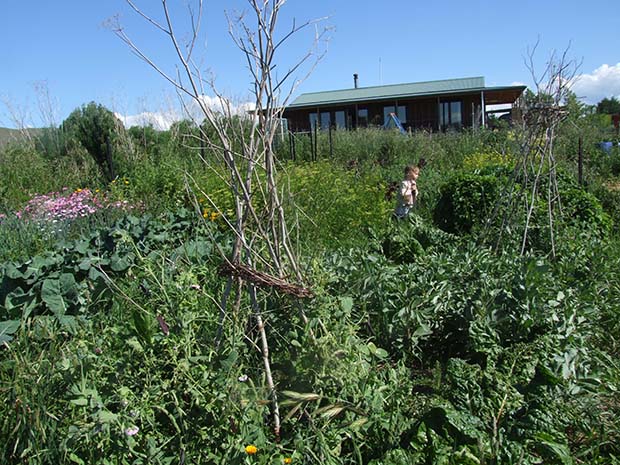
Anna in the family vegetable garden. In the foreground are teepees for the beans made out of fennel stalks and old grape vine prunings.
“This whole valley would have been all kahikatea (Dacrycarpus dacrydioides) once – that’s where our farm gets its name. A few kilometres down the road is a huge lake and the other way is a huge wetland area and we’re by the stream that runs between the two so it was immediately clear we wanted (the lower areas) to be wetlands.
“But we didn’t want to do anything else major, we wanted to see what was going on first.”
Jo and Aaron were then working full-time in town, but they had already worked out the aims and visions for the kind of life they wanted to create, writing them down before they even moved onto their block:
– to create a healthy, integrated, harmonious farm based on the “whole farm” principle of self-sufficiency, nutrient cycling, minimal external inputs and zero waste;
– to nurture the soil as the key foundation for the farm’s wellbeing;
– to be as self-sufficient as possible in food and resources for their physical needs, (eg water, energy, building materials);
– to provide nutritious food for extended family, friends and the local community.
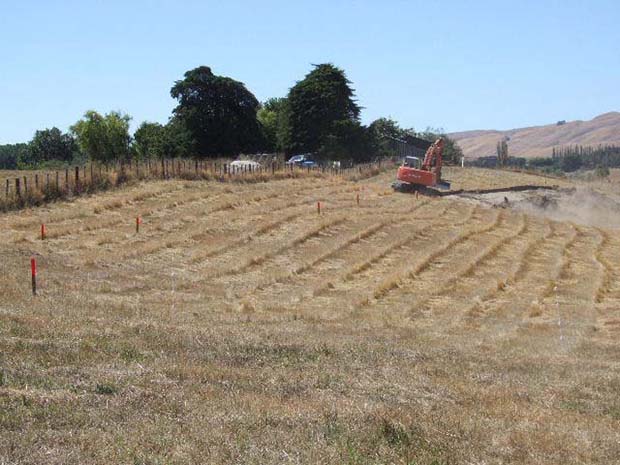
An engineer marked out the contour lines that the swales should follow.
Other aims included creating a retreat that would provide for their (and others’) spiritual needs, to use native plants to create biodiversity, to use exotics where they would have no adverse impact, to recycle, to always learn, and to provide themselves and hopefully others with the “right (ie, fair) livelihood”.
“Permaculture is the big thing in my background,” says Jo. “I started teaching it when we moved here but I’ve been into permaculture for 10 years or so. We knew we wanted to design (the block) using permaculture principles, so we put together that set of aims and visions before we started.”
Some things took a bit of guesswork in the first four years. Permaculture advises that you start with the small areas right outside your doorstep to provide your daily vegetables (zone 1) and herbs, then gradually work your way outwards.
“Then you go a bit further and a bit further but we didn’t have the house then, we were waiting to see where to put it.”
Instead, they planted up the wetland areas and had to put in a driveway.
“We did do the driveway fairly early but only because we kept getting stuck in the mud in winter driving across the paddock to the caravan! And it was guesswork, we allowed for a couple of possible house sites.”
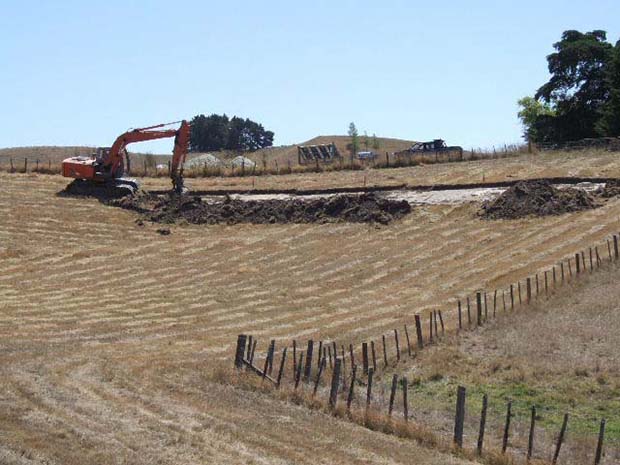
A contractor digging the swales. Dirt was placed on the downhill side to slow water running through the landscape.
By the time Jo and Aaron – with help from the wwoofers who stay with them – are finished, the plan is that you won’t see a blade of grass on Kahikatea Farm, although that is a goal for the long-term as time and finances permit says Jo.
Eventually, about half the block will be a ‘food forest’ or ‘multi-storey farm’. A canopy of trees – nitrogen-fixing and firewood options – will form a canopy, and tree crops to berries to vegetables will grow underneath and in clearings, forming up to seven layers of edible plants. Most things will be self-sown and able to survive on the low rainfall due to natural mulch formation and lots of plant cover. It will also be a complex habitat for birds and insects, self-fertile thanks to the nitrogen-fixing trees and natural composting processes, and highly productive all year round. The forest will also provide firewood, medicinal herbs, and plants for creating dyes.

Aaron and Anna sitting on one of the completed swales.
One of the first ways to start this type of project is with a hedgerow, which the Duffs wanted primarily for shelter.
“That’s one of the first things we planted,” says Jo. “It’s a mixture of plants. At tree size we’ve got crab apples and cherry plums, and when they get up (in height) they’ll need something underneath like flaxes. We’ve got shrubs like hebes, eleagnus – a nitrogen-fixer, depending on the species. We ended up with some variegated ones from a garden centre, we couldn’t find anything else so we thought we’d give it a go.
“We’ve got other natives like griselinia (Griselinia littoralis) and akeake (Dodonaea viscosa) sheltering the rest of the orchard from the north-west winds, then hazelnuts (Corylus avellana) and Chinese hawthorn (Crataegus pinnatifida) which has big berries you can use for jam.”
Two years ago the Duffs got a business opportunity that fitted in perfectly with their aims and visions, supplying seedlings to an organic shop. They were already supplying organic store Cornucopia in Hastings with vegetables and microgreens for Taste, a local organic café.

The Duffs’ stand at the Otane market.
“The seedlings is the main thing and we didn’t ever anticipate doing something like that so it blew our (permaculture) planning out while we set up the infrastructure for the nursery. We’ve got over a hundred different types of vegetable seedlings and herbs in two polytunnels and three shade houses and we’re about to add one more of each.
“We’re getting really good feedback about the seedlings too. A lady I’d never met before came up to me at Cornucopia and she runs a garden course and she tells her students to buy our seedlings.”
The Duffs sell their plants to several other shops and at the local Otane market on a Sunday. Jo says they’re also considering eventually having farm sales.
“We’re just doing a bit of consolidation, beautify it a bit, especially where you first drive in so it will look a bit nicer.
“We’re working on areas around the house but there are whole areas we haven’t even started working on yet. We get some learning experiences in one area, then apply those to another area. Tidying up is what we really need to do… make some of the temporary things permanent, plant more hedgerows along where we’ve got fences.”
Wwoofers (usually international visitors, who volunteer to work on organic properties in return for board) help out with some of the work, and it’s very satisfying to Jo to be able to share their property and teach people too.
“When we have wwoofers it takes about two hours to show them around and we do a lot of teaching as we show them around. That’s really important to me, to show them the context they’re operating in, how they’re contributing to the whole site.”

A new vegetable bed, prepped and ready for planting
Aaron and Jo are also expanding their nursery business to provide a wider range of plants for people who want to grow a variety of food but who only have a small garden. The different features of their business all contribute to the family income, and Jo says they appreciate having that variation.
“We supply a cafe called Taste Organic Café with salad mix and Cornucopia with salad mix, stir fry mix and some bulk things like red and spring onions, garlic, beetroot and Maori potatoes, a few herbs. It’s all very small-scale.
“I do a bit of teaching, we get a bit from the veges, a bit from the seedlings. For us, it’s about the diversity of income.”
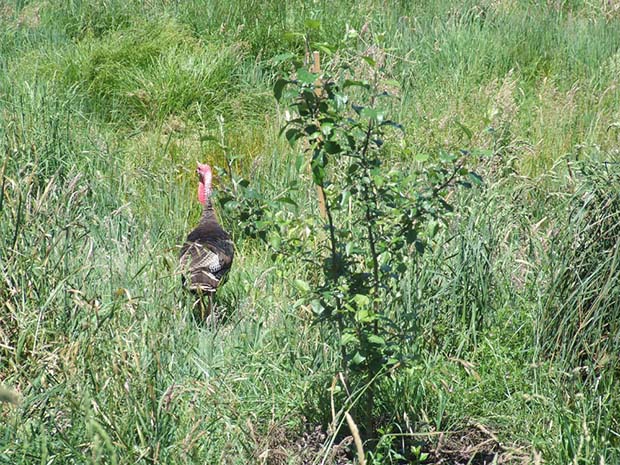
Wild turkeys assist by adding fertiliser.
Their own personal garden is still coming together since the house was only completed in 2010, but it already produces enough veges that they can store, bottle or freeze many crops.
“We bottle a year’s supply of beetroot and we store things like garlic, onions, potatoes – we can usually get six months of storage in the shed, some things we sling up in hammocks to keep it away from the rats.”
Jo originally had beds for annuals around the verandah but they were quickly taken over as beds by their two big pet dogs.
“Dogs and annuals definitely don’t mix! I’m slowly replacing (the annuals) with perennial herbs like lavender; it’s very dry as well so I’m planting a few more drought-tolerant things.”
Everything the Duffs grow for sale is from open-pollinated seeds, saved from their own garden where possible.
“The corn seedlings we sell are not hybrids (F1), the only corn we sell is from Koanga Gardens.
“We’ve got Hawkes Bay Yellow tomatoes, saved by a local seed saver (Henry Harrington): they’re large, not quite beefsteak, nice colour in a salad. We got those originally from Koanga and now we’re saving our own seed.”
For two people who lived in a caravan for four years, their house wasn’t much of a priority until baby Anna was on the way.
“We originally wanted to build a straw bale house and we were in negotiations with council for a couple of years but they wanted certain things that we didn’t want, like lots of steel, and chickenwire and cement plaster but we refused to compromise on all that stuff.
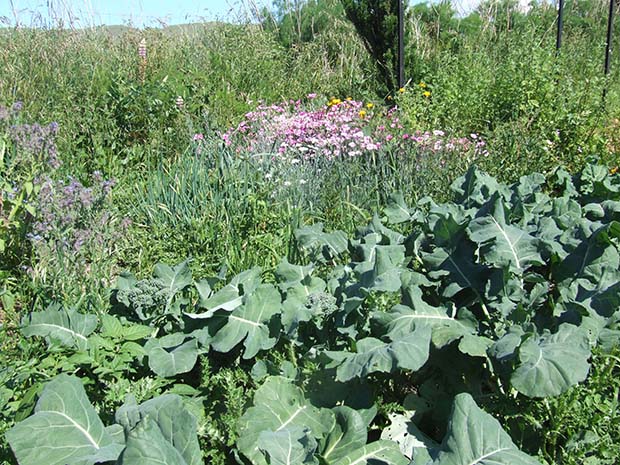
The vegetable garden includes broccoli, tree onions, dianthus (for salads), calendula, borage and rosemary
“When Anna was on the way we decided something was better than nothing so we ended up with a small board and batten house and we’ve just done as much ‘eco’ stuff as we can. We made our own plaster and paints, we’ve got a composting toilet, a greywater recycling system, a wood stove that heats the home and water and food.
“Anna was born in the caravan though and we were fine in there until she was nearly crawling – we got into the house in the nick of time.”
The house is 63m² but add in the covered verandah all the way round and its 80m² in total. It’s also off the grid, running on solar power.
“We always wanted to be on solar power and have always been very conscious of our useage. We had two solar panels (when living in the caravan) but we ramped it up for the house and ended up with more power than we need so we’re able to run our bore pump and we can even plug in the hot water cylinder if we need to (top it up).
“The batteries are full by 10am from mid-spring onwards, and we have quite sunny winters too so it’s a great place to be on solar power. We do top up occasionally from a generator, maybe once a week if the weather isn’t good.”
Going off-grid wasn’t just a philosophical decision. Financially, it was going to cost about the same to run power cables from the road to the house, and that made it an even easier decision says Jo.
“The solar panels are guaranteed for 25 years. The batteries are the only weak point so we’re trying to prolong their lives as long as possible, but they should last 10, maybe 12 years, and maybe technology will have got better by then.”
Although they have a bore, there is also 50,000 litres of water storage in two tanks, with rainwater harvested from the house roof and from their sheds to make sure they always have a good water supply.
When Aaron and Jo first got together, he was a country-born Kiwi who was working long hours in IT and she was an English-born city dweller who’d always hankered after a rural life. Now they’re living what a lot of people consider the good life but Jo says they’re not into self-sufficiency for themselves.
“We into our community being self-sufficient, then the wider region. We don’t want to be self-sufficient where we’ve got everything and our neighbours have got nothing. And I’m not about to run cattle or sheep – if we wanted to eat them, we’d negotiate with our neighbours over what we could trade. We have much more space than we need for one family so the surplus can be traded or given away.”
It all seems like a lot of work that could easily get on top of you, but Jo says she never sees any of it as depressing or too much to cope with.
“It’s just very frustrating sometimes because there aren’t enough hours in the day and there are so many exciting projects we want to do! But we had two years (2009-2010) when we built a house, had two babies and started a business and I figure if we managed that, we can manage anything!”
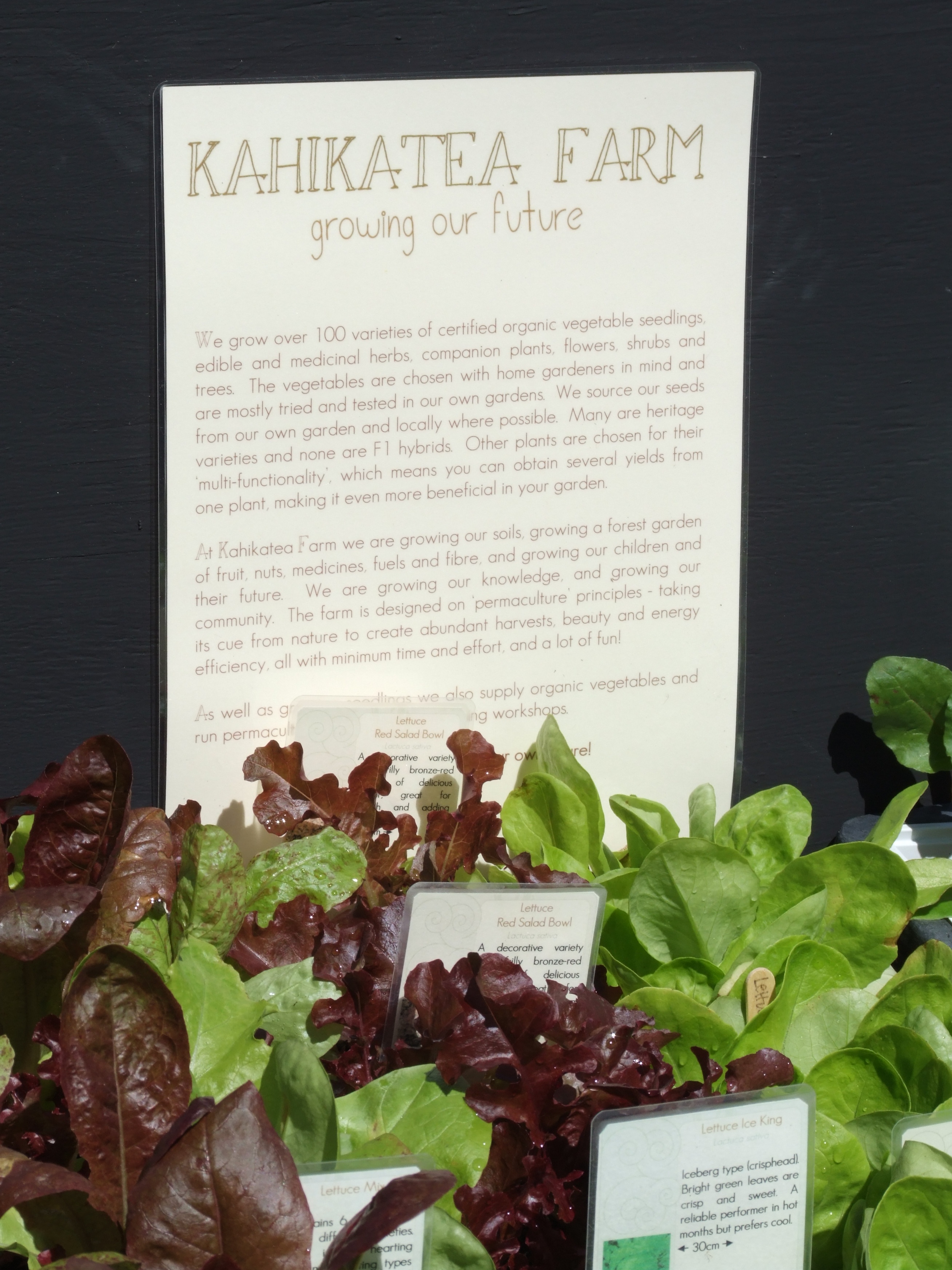
Kahakatea at the local market
A KEY TO PERMACULTURE SUCCESS
The Duffs’ block is clay soil in a low rainfall zone so utilising every drop of rainwater that falls for as long as possible is vital.
In permaculture – which originated in Australia – swales (or ditches) are dug along contour lines on slopes to slow water as it falls through the landscape by spreading it horizontally. Trees and other plants are put in on the downside slope to soak up as much moisture as possible. It’s an experiment in progress on their farm says Jo.
“We did some earthworks, put in swales and ponds in different places, all in low-lying spots.
“The swales follow the contour – we had them designed by a friend who is an engineer and a permaculture designer so she knew what she
was doing.
“They’re all slightly different, and our farm is so narrow – varying from 500m to 200m wide, maybe a bit more – and the contour would naturally run the water onto the properties on either side so ours are about holding water on-site for longer so we can use it.”
The swales currently have tagasaste and fruit trees planted on the downward slopes and eventually they will form part of the Duffs’ food forest as different micro-climates form.
“On the east side we’ve got pears and plums and apples, then lower down we’ve got another little swale and we’ve got pears and quince as they tolerate having wetter feet.
“On the north side we’ve got citrus – it’s struggling a bit, but we’re pretty laissez-faire about it – there’s cherries and apricots, then on top of the hill are nectarines and peaches that don’t mind the wind. There’s a few other random bits and pieces, an Irish strawberry tree (Arbutus unedo), medlar (Mespilus germanica), lots of unusual things we’ve come across.”
In Australia, the soil is worked into swales in winter and then sown, but that wasn’t possible on the Duffs’ block. The wet clay in winter was too soft for a digger to work on, so they had to wait until summer, which then meant sowing couldn’t be done because it was too dry and hot. That has caused some unique issues for their particular brand of permaculture says Jo.
“We don’t irrigate out there, so what’s happened is the grass from the paddocks has come romping back over the swales so over time we’ve had to fight the grass. We mulched (the trees) but it would grow back over them so we’re having to sheet mulch areas and that’s taking a long time. We might only get to do a few metres each year, but we just do what we can.”
Love this story? Subscribe now!
 This article first appeared in NZ Lifestyle Block Magazine.
This article first appeared in NZ Lifestyle Block Magazine.

